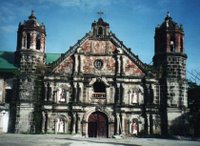 In the Kapampangan language, churches are called pisamban. One of the very first websites I made way back in college was on the churches of Pampanga. I remember that I spent two weeks traveling around the province of Pampanga searching for its heritage sites. At that time, there was no inventory of heritage sites. And the information and photos I collected eventually became the jump off point for the heritage conservation campaign in Pampanga.This I made available on the net through the website Pisamban: Churches of Pampanga (as of October 2009, Geocities is no longer online) among others. I was no longer able to update it since the files were lost when my computer crashed several years back. Above is a photo of the Minalin Church while the one below can be found in San Luis. Anyway, there are more photos of Pampanga and San Fernando heritage churches and other structures in my Yahoo! Photos.
In the Kapampangan language, churches are called pisamban. One of the very first websites I made way back in college was on the churches of Pampanga. I remember that I spent two weeks traveling around the province of Pampanga searching for its heritage sites. At that time, there was no inventory of heritage sites. And the information and photos I collected eventually became the jump off point for the heritage conservation campaign in Pampanga.This I made available on the net through the website Pisamban: Churches of Pampanga (as of October 2009, Geocities is no longer online) among others. I was no longer able to update it since the files were lost when my computer crashed several years back. Above is a photo of the Minalin Church while the one below can be found in San Luis. Anyway, there are more photos of Pampanga and San Fernando heritage churches and other structures in my Yahoo! Photos. Just to update everyone regarding our petition to the CBCP, we've collected more than 500 signatures to date and more are still coming in. It has been gaining so much momentum, international attention and support is pouring in as well. We have received letters of support from international conservation agencies such as the World Monuments Fund, the International Council on Monuments and Sites (ICOMOS) and its various national committees worldwide, and the Partners for Sacred Places among many others. If you haven't signed yet, please do at http://www.petitiononline.com/cbcp.
Just to update everyone regarding our petition to the CBCP, we've collected more than 500 signatures to date and more are still coming in. It has been gaining so much momentum, international attention and support is pouring in as well. We have received letters of support from international conservation agencies such as the World Monuments Fund, the International Council on Monuments and Sites (ICOMOS) and its various national committees worldwide, and the Partners for Sacred Places among many others. If you haven't signed yet, please do at http://www.petitiononline.com/cbcp.
The Vatican actually has a Pontifical Commission for the Cultural Heritage of the Church. In a 2001 circular letter, its president His Eminence Francesco Cardinal Marchisano says, "The cultural treasures of the Church make up the specific patrimony of the Christian community. At the same time, as a result of the universal dimension of the Christian message, they belong to the whole of humanity. Their end is the same as the Church's mission in its twofold work of Christian evangelization and promoting the human being. Their value lies in highlighting the activity of inculturating the faith. (emphasis mine)"
He adds, “The value that the Church places on her cultural goods explains ‘the will on the part of the community of faithful, and in particular ecclesiastical institutions, to gather since the apostolic period the testimonies of faith and nourish their memory, express the uniqueness and continuity of the Church that lives out these last periods of history’ (Pontifical Commission for the Cultural Heritage of the Church, Circular Letter The Pastoral Function of Church Archives, see n. 1.1.). Thus, the Church considers as crucial the handing down of her own patrimony of cultural goods. They represent, in fact, an essential link in the chain of Tradition; they are the visible memory of evangelization; they become a pastoral instrument. It follows therefore the effort ‘to restore, preserve, catalogue, and protect’ them (John Paul II, Address of October 12, 1995, see n. 4) in order to assure that they are treasured, ‘thus promoting a greater knowledge and suitable use in catechesis and in the liturgy’ (ibid.). (emphasis mine again)”
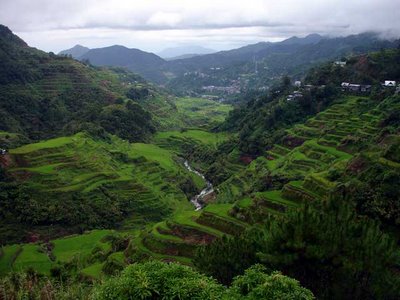 Just got back from an exhausting but fulfilling day trip to the Cordilleras. Yes, you heard me right, it was a day trip! This time the HCS was off to Bontoc, Mountain Province where a rare American period upland capitol building still stands.We all met up at Gemma's place at 11 p.m. Saturday night and were off at about 12 midnight. It was going to be a long drive up Maharlika Highway so we went to sleep for most of the trip stopping only for a short break in Bambang, Nueva Vizcaya. In Baliuag, we were caught in a major traffic jam in the brewing since an AUV had crashed into a telephone post and as a result, the wires were dangling quite low making it difficult for trucks to pass. Since it is a major truck route, imagine the long line that resulted from the accident. Anyway, we were able to manuever our way in just a few minutes but we could imagine the traffic jam we were to face if we had arrived minutes later.
Just got back from an exhausting but fulfilling day trip to the Cordilleras. Yes, you heard me right, it was a day trip! This time the HCS was off to Bontoc, Mountain Province where a rare American period upland capitol building still stands.We all met up at Gemma's place at 11 p.m. Saturday night and were off at about 12 midnight. It was going to be a long drive up Maharlika Highway so we went to sleep for most of the trip stopping only for a short break in Bambang, Nueva Vizcaya. In Baliuag, we were caught in a major traffic jam in the brewing since an AUV had crashed into a telephone post and as a result, the wires were dangling quite low making it difficult for trucks to pass. Since it is a major truck route, imagine the long line that resulted from the accident. Anyway, we were able to manuever our way in just a few minutes but we could imagine the traffic jam we were to face if we had arrived minutes later.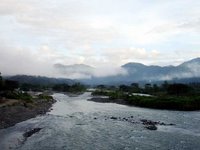 From Maharlika Highway, we made a left in Bagabag towards Banaue. By the time we entered Ifugao, the sun was up. The scenery along the way was just surreal and we had wanted to stopover by a river for a breakfast picnic but had to abandon the plan since it was difficult to find our way down to the riverbank. We had made it past Lagawe, Ifugao's capital town when we decided to find a spot along the mountain road for our picnic.
From Maharlika Highway, we made a left in Bagabag towards Banaue. By the time we entered Ifugao, the sun was up. The scenery along the way was just surreal and we had wanted to stopover by a river for a breakfast picnic but had to abandon the plan since it was difficult to find our way down to the riverbank. We had made it past Lagawe, Ifugao's capital town when we decided to find a spot along the mountain road for our picnic.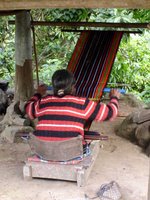 We found a clearing where we parked. Gemma had prepared cold cuts, bread, cheese, and steamed brussel sprouts and carrots, a healthy treat indeed! Then we noticed we had a flat tire. And to make things worse, there was one stubborn screw which broke our tire wrench. So the driver had to hitchhike to Banaue to look for a vulcanizing shop for help. Anyway, we were stuck for close to two hours. And by this time, Gemma had sent an SOS to the governor of Mountain Province. So a vehicle was on the way. But Bontoc was two hours away! So we just enjoyed the view and watched an old Ifugao lady weave some cloth the traditional way.
We found a clearing where we parked. Gemma had prepared cold cuts, bread, cheese, and steamed brussel sprouts and carrots, a healthy treat indeed! Then we noticed we had a flat tire. And to make things worse, there was one stubborn screw which broke our tire wrench. So the driver had to hitchhike to Banaue to look for a vulcanizing shop for help. Anyway, we were stuck for close to two hours. And by this time, Gemma had sent an SOS to the governor of Mountain Province. So a vehicle was on the way. But Bontoc was two hours away! So we just enjoyed the view and watched an old Ifugao lady weave some cloth the traditional way.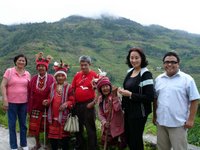 When the driver came back, they were able to replace the tire only to realize that the spare was soft as well. Oh brother! So we made a slow drive to Banaue where we had the tire inflated, pausing briefly for photos with the Banaue Rice Terraces. Sad to say, the view from Banaue town is now that of the Banaue House Terraces! Sigh! And you have to drive further out of town for better views. I wonder why the local government of Banaue did not regulate the construction and development in their area. Didn't they realize that they themselves are destroying the beauty of the rice terraces they are promoting to tourists?
When the driver came back, they were able to replace the tire only to realize that the spare was soft as well. Oh brother! So we made a slow drive to Banaue where we had the tire inflated, pausing briefly for photos with the Banaue Rice Terraces. Sad to say, the view from Banaue town is now that of the Banaue House Terraces! Sigh! And you have to drive further out of town for better views. I wonder why the local government of Banaue did not regulate the construction and development in their area. Didn't they realize that they themselves are destroying the beauty of the rice terraces they are promoting to tourists?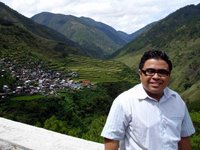 A few kilometers from Banaue, we finally saw the vehicle sent by the governor and decided to transfer. Since the driver was already used to driving along the rough mountain road, we were moving faster now. Of course, we could not resist the photo opportunities along the way, views of mountain villages such as Bayyo, perched beside the rice terraces which their ancestors built. Then we saw Bontoc, the capital town which appeared like a hidden metropolis in the mountains. It's sad though that the current architecture in the Philippines is so nondescript and lacks character. The view of Bontoc would have been more charming if the architectural character of the place was maintained.
A few kilometers from Banaue, we finally saw the vehicle sent by the governor and decided to transfer. Since the driver was already used to driving along the rough mountain road, we were moving faster now. Of course, we could not resist the photo opportunities along the way, views of mountain villages such as Bayyo, perched beside the rice terraces which their ancestors built. Then we saw Bontoc, the capital town which appeared like a hidden metropolis in the mountains. It's sad though that the current architecture in the Philippines is so nondescript and lacks character. The view of Bontoc would have been more charming if the architectural character of the place was maintained.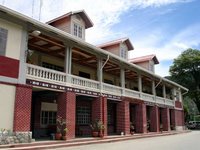 We went straight to the capitol to take photos for our 2007 HCS Calendar. The facade of the capitol had just been renovated in April, the wooden windows replace by metal ones. Sigh! But most of it was still intact. So we took our photos.Governor Maximo Dalog, who had graciously sent his vehicle to rescue us, was there to meet us. Inside his office, he served us native coffee and patupat, their native rice cake which was shaped into small triangles. We stayed in his office for quite a while since Gemma interviewed him for her TV and radio show.
We went straight to the capitol to take photos for our 2007 HCS Calendar. The facade of the capitol had just been renovated in April, the wooden windows replace by metal ones. Sigh! But most of it was still intact. So we took our photos.Governor Maximo Dalog, who had graciously sent his vehicle to rescue us, was there to meet us. Inside his office, he served us native coffee and patupat, their native rice cake which was shaped into small triangles. We stayed in his office for quite a while since Gemma interviewed him for her TV and radio show.
We had lunch at the Cable Cafe & Restaurant which was located in an old upland house. You could see the difference between the lowland and upland dwellings and sadly, there are not much of these colonial mountain homes and shophouses left. Before lunch, we were treated to an impromptu wine-tasting session as various lang-ay festival wines were brought out. They served us sorelle (cacao), bugnay and rice wines which were really great! I mixed some bugnay and sorelle wine with my pineapple juice and the result was a delicious cocktail which Gemma named Bontoc Embrace. Hehe!
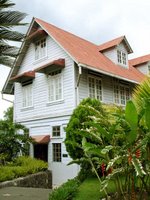 After the hearty lunch, we were brought to the Bontoc Museum which was housed in buildings designed like Bontoc huts. Right beside it was an old Catholic school founded in 1911, the St. Vincent's Elementary School which was a complex of wooden and brick buildings (more photos here). I had noticed a sign which showed a new building and fund-raising efforts for it. So I asked where it was going to be built. And to my horror, they were going to demolish some old ones.
After the hearty lunch, we were brought to the Bontoc Museum which was housed in buildings designed like Bontoc huts. Right beside it was an old Catholic school founded in 1911, the St. Vincent's Elementary School which was a complex of wooden and brick buildings (more photos here). I had noticed a sign which showed a new building and fund-raising efforts for it. So I asked where it was going to be built. And to my horror, they were going to demolish some old ones.
So I immediately talked to the governor and it turned out that the tourism officer who was with us was the president of the parents' association of the school. So we were able to make them realize the value of the old buildings and they will be contacting some heritage architects for advise on how to go about restoring them.
 Our plan was to visit nearby Sagada and Maligcong Rice Terraces but thanks to our flat tire fiasco, we had to make our way back to Manila. Sigh! This time, we stopped along the road for more photos. Despite the rough road which the governor calls the "Bontoc Massage," the view of the natural heritage of the Philippines at its finest makes any trip up the Cordilleras most worth it. I hope it stays that way!
Our plan was to visit nearby Sagada and Maligcong Rice Terraces but thanks to our flat tire fiasco, we had to make our way back to Manila. Sigh! This time, we stopped along the road for more photos. Despite the rough road which the governor calls the "Bontoc Massage," the view of the natural heritage of the Philippines at its finest makes any trip up the Cordilleras most worth it. I hope it stays that way!
One of our last stops was the marker of the Philippine Institute of Civil Engineers and the American Society of Civil Engineers (more photos here). Aside from being a National Cultural Treasure and a UNESCO World Heritage Site, the Ifugao Rice Terraces had also been designated as an International Historic Civil Engineering Landmark. So that is more reason to preserve it, moreso since it was among the 100 Most Endagered Sites for 2000, and still among 34 sites listed in the World Heritage in Danger List.
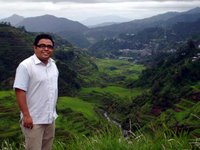 This marked viewpoint offers one of the better views of the rice terraces in Banaue. I think this viewpoint was the highlight of our trip thanks to the magnificent view and the cool mountain weather. From there, we proceeded to the Banaue Hotel where we had some coffee.
This marked viewpoint offers one of the better views of the rice terraces in Banaue. I think this viewpoint was the highlight of our trip thanks to the magnificent view and the cool mountain weather. From there, we proceeded to the Banaue Hotel where we had some coffee.
After coffee, it was off to Manila and another long nap. And we thought it was all over when we realized when we stopped over in Cabanatuan that our aircon fanbelt was broken. Good thing the weather was cool so the trip back to Manila wasn't that uncomfortable and the next thing I knew, we were back in Makati, a little over 24 hours after we had departed. It's now time to get more sleep! Hehe!
I just made a petition to the Catholic Bishops Conference of the Philippines (CBCP). To read and sign the petition, please visit http://www.petitiononline.com/cbcp. To check out who's signed the petition and what they have to say, click here.
A Filipino society that values and preserves its cultural heritage in order to instill pride of place and strengthen Philippine national identity... we can all make a big difference in our fight to preserve our cultural heritage!
 In the Kapampangan language, churches are called pisamban. One of the very first websites I made way back in college was on the churches of Pampanga. I remember that I spent two weeks traveling around the province of Pampanga searching for its heritage sites. At that time, there was no inventory of heritage sites. And the information and photos I collected eventually became the jump off point for the heritage conservation campaign in Pampanga.
In the Kapampangan language, churches are called pisamban. One of the very first websites I made way back in college was on the churches of Pampanga. I remember that I spent two weeks traveling around the province of Pampanga searching for its heritage sites. At that time, there was no inventory of heritage sites. And the information and photos I collected eventually became the jump off point for the heritage conservation campaign in Pampanga. Just to update everyone regarding our petition to the CBCP, we've collected more than 500 signatures to date and more are still coming in. It has been gaining so much momentum, international attention and support is pouring in as well. We have received letters of support from international conservation agencies such as the World Monuments Fund, the International Council on Monuments and Sites (ICOMOS) and its various national committees worldwide, and the Partners for Sacred Places among many others. If you haven't signed yet, please do at http://www.petitiononline.com/cbcp.
Just to update everyone regarding our petition to the CBCP, we've collected more than 500 signatures to date and more are still coming in. It has been gaining so much momentum, international attention and support is pouring in as well. We have received letters of support from international conservation agencies such as the World Monuments Fund, the International Council on Monuments and Sites (ICOMOS) and its various national committees worldwide, and the Partners for Sacred Places among many others. If you haven't signed yet, please do at http://www.petitiononline.com/cbcp.








